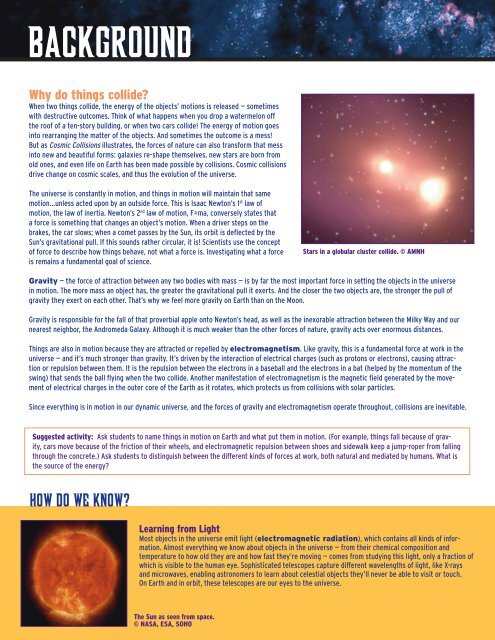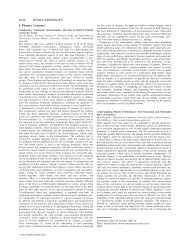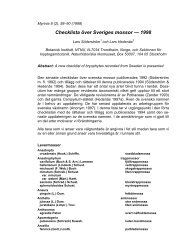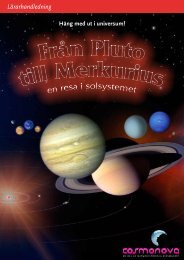Cosmic Collisions
Cosmic Collisions
Cosmic Collisions
You also want an ePaper? Increase the reach of your titles
YUMPU automatically turns print PDFs into web optimized ePapers that Google loves.
Background<br />
Why do things collide?<br />
When two things collide, the energy of the objects’ motions is released — sometimes<br />
with destructive outcomes. Think of what happens when you drop a watermelon off<br />
the roof of a ten-story building, or when two cars collide! The energy of motion goes<br />
into rearranging the matter of the objects. And sometimes the outcome is a mess!<br />
But as <strong>Cosmic</strong> <strong>Collisions</strong> illustrates, the forces of nature can also transform that mess<br />
into new and beautiful forms: galaxies re-shape themselves, new stars are born from<br />
old ones, and even life on Earth has been made possible by collisions. <strong>Cosmic</strong> collisions<br />
drive change on cosmic scales, and thus the evolution of the universe.<br />
The universe is constantly in motion, and things in motion will maintain that same<br />
motion…unless acted upon by an outside force. This is Isaac Newton’s 1 st law of<br />
motion, the law of inertia. Newton’s 2 nd law of motion, F=ma, conversely states that<br />
a force is something that changes an object’s motion. When a driver steps on the<br />
brakes, the car slows; when a comet passes by the Sun, its orbit is defl ected by the<br />
Sun’s gravitational pull. If this sounds rather circular, it is! Scientists use the concept<br />
of force to describe how things behave, not what a force is. Investigating what a force<br />
is remains a fundamental goal of science.<br />
Gravity — the force of attraction between any two bodies with mass — is by far the most important force in setting the objects in the universe<br />
in motion. The more mass an object has, the greater the gravitational pull it exerts. And the closer the two objects are, the stronger the pull of<br />
gravity they exert on each other. That’s why we feel more gravity on Earth than on the Moon.<br />
Gravity is responsible for the fall of that proverbial apple onto Newton’s head, as well as the inexorable attraction between the Milky Way and our<br />
nearest neighbor, the Andromeda Galaxy. Although it is much weaker than the other forces of nature, gravity acts over enormous distances.<br />
Things are also in motion because they are attracted or repelled by electromagnetism. Like gravity, this is a fundamental force at work in the<br />
universe — and it’s much stronger than gravity. It’s driven by the interaction of electrical charges (such as protons or electrons), causing attraction<br />
or repulsion between them. It is the repulsion between the electrons in a baseball and the electrons in a bat (helped by the momentum of the<br />
swing) that sends the ball fl ying when the two collide. Another manifestation of electromagnetism is the magnetic fi eld generated by the movement<br />
of electrical charges in the outer core of the Earth as it rotates, which protects us from collisions with solar particles.<br />
Since everything is in motion in our dynamic universe, and the forces of gravity and electromagnetism operate throughout, collisions are inevitable.<br />
How Do We Know?<br />
Stars in a globular cluster collide. © AMNH<br />
Suggested activity: Ask students to name things in motion on Earth and what put them in motion. (For example, things fall because of gravity,<br />
cars move because of the friction of their wheels, and electromagnetic repulsion between shoes and sidewalk keep a jump-roper from falling<br />
through the concrete.) Ask students to distinguish between the different kinds of forces at work, both natural and mediated by humans. What is<br />
the source of the energy?<br />
Learning from Light<br />
Most objects in the universe emit light (electromagnetic radiation), which contains all kinds of information.<br />
Almost everything we know about objects in the universe — from their chemical composition and<br />
temperature to how old they are and how fast they’re moving — comes from studying this light, only a fraction of<br />
which is visible to the human eye. Sophisticated telescopes capture different wavelengths of light, like X-rays<br />
and microwaves, enabling astronomers to learn about celestial objects they’ll never be able to visit or touch.<br />
On Earth and in orbit, these telescopes are our eyes to the universe.<br />
The Sun as seen from space.<br />
© NASA, ESA, SOHO

















